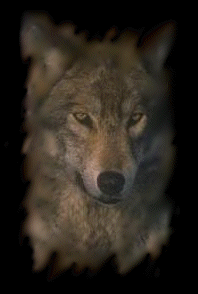
Communication
Wolves express themselves vocally through a variety of howls, yips, squeals, growls, chirps, and barks. Wolves howl for many reasons, including the following:
Postures
Dominant Postures-
Include walking with head held high, tail partly erect, eyes directed straight toward other wolves. Dominant animals may show raised hackles, may growl, and may side-swipe or body-slam into subordinate animals, sometimes pinning them to the ground. They may show bared teeth, upright ears, or a wrinkled forehead. They may seize the muzzle of subordinates, and nip or bite them. Dominate animals tend to be the first to eat at kills, the first to attack in aggressive encounters with other packs, and tend to have breeding rights not enjoyed by lower-ranked members.
Subordinate Postures-
Include lowered tails (in extreme submission curled right under the body), ears folded back, the peeling back of lips to form a submissive "grin", crouching or lowered body position. A subordinate animal mat lick a superior wolf's muzzle, or lie on it's side, raising a hind leg to expose the groin area to the superior. It may bend it's head back to expose the throat area, and in extreme submission, may urinate on itself. Subordinate animals may also whine or squeal in submission to superior wolves, making timid, small steps toward superiors with one forepaw lifted up.
Subordinate animals often actively solicit responses from more dominant pack members in order to reaffirm their status and pack position. Though many of these ritual gestures appear vicious, they actually serve to preserve pack cohesion without bloodshed.

